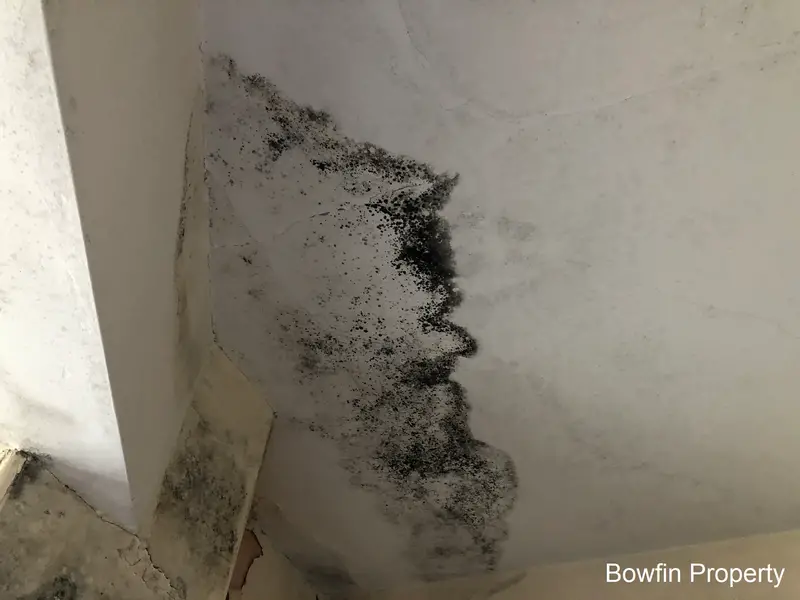
If you’ve found damp in a house after purchasing it you may be kicking yourself you didn’t have a full survey done beforehand. You may be wondering if you have a legal case against the vendor, especially if they’ve tried to hide the damp from surveyors.
The only reason you’ll find damp in a house after purchasing it is if you didn’t have a full survey done to uncover any damp problems. A basic survey or a valuation report will not necessarily uncover any damp problems, so caveat emptor or buyer beware and do your checks before you buy.
One of my first investment properties had damp, and I agreed with the vendor a reduction in the purchase price. What I failed to do before completing on the deal was to have a full costing done to fix the problem, which was a mistake. The reduction in the asking price from memory (bearing in mind this was nearly 20 years ago so I can’t remember exactly), was about £1,000, but the quote to fix the damp problem was closer to £5,000. A lesson learned in property buying.
Please also read this article to discover how you could save £71,475 on your next mortgage if you sell your house and rent before buying again. Even I was amazed when I did the calculations! The strategies you learn in this article will not only save you money, but it will also reduce the stress of buying your next home.
Problems with house after buying UK
If you find problems with a house after buying it in the UK which is something you or the surveyor missed, the seller will not necessarily be legally required to compensate you or put the matter right. But the surveyor may be legally responsible if they failed to find the problem during the survey.
What happens if you buy a house with damp?
If you buy a house with damp you should have it checked by a qualified survey to discover the type of damp problem you have. It’s probably too late to go back to the seller and ask them to pay for the damp issue, but if you had a survey it might be the surveyor is liable for the cost of it to be rectified.
What if the seller knew about the damp but was not asked?
If you’ve bought a house with damp problems which were not disclosed by the seller, this is unlikely to give rise to a claim for misrepresentation. This is because in the UK the principle of ‘caveat emptor’ or ‘buyer beware’ applies.
If you didn’t ask the seller a question, which in this case was: “does the property have any damp problems“, you cannot look to the seller for compensation. It is down to you to find the problems with the house by paying for a survey, paying for property searches and paying a solicitor to carry out appropriate checks and to ask the right questions.
If a question about damp has not been asked by you as the buyer or by your solicitor, it cannot be said that you relied on anything the seller said when deciding to buy the property.
Having said that, if the seller fails to mention something that is ‘material‘ to the transaction, it might be possible to claim misrepresentation.
But it’s unlikely that a damp problem would be material to the transaction, because if the damp problem were so materially bad to affect the property in such a bad way, it’s likely that the damp issue would be very obvious when you viewed the property, even if you’re not a damp expert.
At the very least, the property would have had a very bad damp smell, even if the signs of penetrating or rising damp were not obvious on the walls of the property.
What if the seller painted over damp?
If the seller painted over the damp, it’s difficult to prove that they deliberately hid the damp problem, and it is up to the buyer to carry out appropriate checks. This includes a damp survey as part of the full house survey to check for penetrating damp or rising damp.
Whilst a seller can paint over damp to disguise the problem, a survey should still pick this up. With a full survey that includes a damp check the surveyor will use a handheld moisture meter to check the walls. This moisture meter will be pushed into the plaster of the wall and through the paintwork, which if any damp is present will give a damp reading.
Seller lied about damp problem during conveyancing
If the seller was asked about damp and said no there isn’t any, and you find damp in the house after the purchase, depending on whether or not the seller innocently, negligently or fraudulently answered the questions inaccurately, you may be entitled to claim damages from the seller.
The amount of damages that could be awarded to you as a buyer will be based on a diminution in value‘. A diminution in value is the difference between what you would have paid for the property if you knew about the damp problem and what you actually paid for it.
But the amount of damages may not necessarily be equal to the total of the costs to fix the problem, which means the compensation could be less than what it costs to fix it.
However, you have to be prepared to take the sellers to court, which can be very costly. The legal fees to fight the sellers might end up costing more than the award for damages, and there’s no guarantee you’ll receive all your costs. On top of that, going through the court process is stressful too.
Will the Seller Property Information Form protect you?
The standard Seller Property Information Form doesn’t normally include questions about damp, other than to ask about damp proofing guarantees, but if your solicitor has not asked about damp, it’s unlikely the seller can be held to account.
However, if your solicitor has specifically asked a separate question about damp in the property, and the seller knowing misled you, you may have recourse to sue the seller.
Can someone sue after buying a house UK
Buyers can sue sellers for misrepresentation after buying a house if the seller misrepresented the property or did something that could be construed as fraud or as a breach of the sales agreement. This could be the seller painted over damp and failed to disclose the problem when asked the question.
If you had a survey done when buying the house, and this failed to find the damp problem, you may be able to claim against the surveying company for negligence.
Final thoughts on found damp in house after purchase
Makes sure you check if the damp problem is in fact rising damp or penetrating damp, rather than as a result of a condensation problem in the house. Condensation is usually cheap and easy to resolve, and can be as simple as installing or fixing an extractor fan in a bathroom or in the kitchen, installing vents to vent moisture, or by using a clothes dryer instead of hanging washing on radiators.
Buy yourself a small handheld damp meter, which you can get from most DIY stores or online. Check the suspected areas for damp in the wall by pushing the damp meter prongs into the plaster. If there are low moister readings from the wall, this might suggest the mould on the wall is from condensation instead of from penetrating or rising damp.
Be careful when choosing a damp professional, as often times damp companies are looking for work and not all damp companies are so honest when it comes to diagnosing what type of damp you have.
You may like to take a read of this article: How Do I Get Rid Of Damp Quickly From My House. The article explains more about the three types of damp, which includes:
- Condensation (easy and cheap to fix);
- Penetrating damp (also usually easy to fix and will often be obvious like a broken gutter); or
- Rising damp (very rare and more expensive to fix if you have it).
Finally, if you have the worst case scenario and you have rising damp, it’s likely to cost more in legal fees to pursue the seller than it will cost to rectify the problem, and you’ll possibly be throwing good money after bad (and you may not win the case in any event).
If this does cost you a few thousand to fix the damp problem, learn from the mistake and next time you buy a property, pay for a survey. You have learned a hard and possibly expensive lesson, which will hopefully never happen again. We are all fallible, and as explained above I made a costly mistake myself when I bought a property, but I’ve not made the same mistake since.
Next time you’re buying a property, think about how much you’re spending on that property, which is likely to be in excess of £100,000. Paying for a full structural survey may cost a few hundred Pounds, but as a percentage of your overall investment, it’s a small price to pay for peace of mind.
Please don’t forget to read this before you leave…
Please don’t forget to also read this article to discover how you could save £71,475 on your next mortgage if you sell your house and rent before buying again. As I said earlier, even I was amazed when I did the calculations! Learn about how you will reduce the stress of moving house, whilst at the same time potentially save thousands in the process!
I hope you’ve enjoyed this article about found damp in house after purchase
f you’ve enjoyed this article about “found damp in house after purchase” please share it on your favourite social media site.
Also, if you have any questions, please feel free to comment below too. Please also share any of your experiences with properties you’ve bought. Alternatively, if you need more help, please feel free to contact us on our contact us page here. Or join the discussion and ask your question in the property forum.




